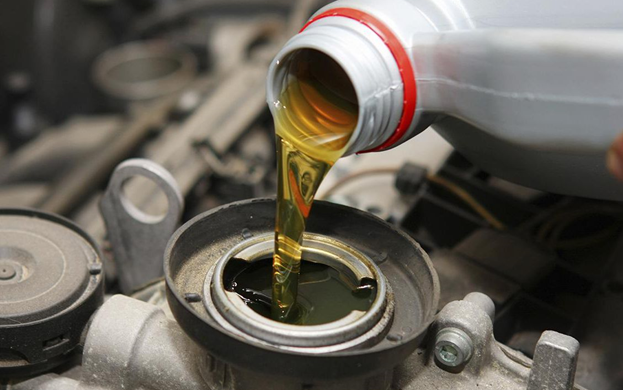Description of Motor Oil:
Motor Oil is comprised of two basic components–base oils and additives. The base oils constitute 70-90 percent of the total and are created from natural gas or crude oil, while additives round out the remaining 10-30 percent and can be variety of things.
These additives include among other things:
Dispersants
Detergents
Anti-wear additives
Friction modifiers
Antioxidants
Anti-foam additives
Corrosion inhibitors
Viscosity index improvers
Pour point depressants
The viscosity of oil:
The viscosity of an oil is measured by its resistance to flow. There are two numbers that define the viscosity of an oil. The first number ends with the letter ‘W’, which stands for Winter.
This measurement is related to how an oil flows when it is cold, such as at engine start-up. The second number is defined by how an oil flow when at higher temperatures normal engine operating temperatures.
The smaller the number, the better it will flow. So, a 5W-30 will flow easier than a 10W-30 at start-up temperatures and a 10W-30 will flow easier than a 10W-40 at normal engine operating temperatures.
This is important, as engine oils naturally thicken as they cool and thin as they are heated. Thin, low viscosity oils flow easier to protect engine parts at cold temperature.
Thick, high viscosity oils are typically better at maintaining film strength to protect engines at high temperatures.
Motor oil, engine oil, or C is any of various substances comprising base oils enhanced with various additives, particularly antiwear additive in addition to detergents, dispersants and, for multi-grade oils, viscosity index improvers. Motor oil is used for lubrication of internal combustion engines.
The main function of motor oil is to reduce friction and wear on moving parts and to clean the engine from sludge (one of the functions of dispersants) and varnish (detergents).
It also neutralizes acids that originate from fuel and from the oxidation of the lubricant (detergents), improves sealing of piston rings, and cools the engine by carrying heat away from moving parts.
In addition to the aforementioned basic constituents, almost all lubricating oils contain corrosion and oxidation inhibitors.
Motor oil may be composed of only a lubricant base stock in the case of non-detergent oil, or a lubricant base stock plus additives to improve the oil’s detergency, extreme pressure performance, and ability to inhibit corrosion of engine parts.
Motor oils today are blended using base oils composed of petroleum-based hydrocarbons, polyalphaolefins (PAO), or their mixtures in various proportions, sometimes with up to 20% by weight of esters for better dissolution of additives.
Uses of Motor Oil:
Motor oil is a lubricant used in internal combustion engines, which power cars, motorcycles, lawnmowers, engine-generators, and many other machines.
In engines, there are parts that move against each other, and the friction wastes otherwise useful power by converting the kinetic energy to heat.
It also wears away those parts, which could lead to lower efficiency and degradation of the engine. This increases fuel consumption and decreases power output and can lead to engine failure.
Lubricating oil creates a separating film between surfaces of adjacent moving parts to minimize direct contact between them, decreasing heat caused by friction and reducing wear, thus protecting the engine. In use, motor oil transfers heat through conduction as it flows through the engine.
In an engine with a recirculating oil pump, this heat is transferred by means of airflow over the exterior surface of the [oil pan], airflow through an oil cooler, and through oil gases evacuated by the Positive Crankcase Ventilation (PCV) system.
While modern recirculating pumps are typically provided in passenger cars and other engines similar or larger in size, total loss oiling is a design option that remains popular in small and miniature engines.
Motor Oil Grades
Take a look at some internationally used engine oil grades
0W-20 This engine oil is relatively thinner when you start the engine. Here in 0W-20, the viscosity of the oil is 0 when the motor is cold. When the engine reaches its normal operating temperature the viscosity of the oil becomes 20.
0W-30 The 0W-30 oil is engineered to behave as a 0-weight oil at the starting temperature and a 30-weight oil when the engine reaches its normal operating temperature.
0W-40 The 0W-40 oil is engineered to behave as a 0-weight oil at the starting temperature and a 40-weight oil when the engine will reach its normal operating temperature.
5W-30 is the most commonly available and most extensively used engine oil in the Indian market. Most of the Indian car manufacturers recommend this.
5W-40 is the fully synthetic engine oil which performs like a 5-weight engine oil when experiencing a cold start. It acts like a 40-weight oil once the engine reaches normal operating temperature.
10W-40 is the engine oil which offers a 10-weight performance in the cold starting temperature. On the other hand, it provides a 40-weight performance at the normal operating temperature of the engine.
TYPES OF OIL ADDITIVES
Motor oils typically include a few additives which can make up between 5% and 30% of the oil. These additives help enhance the performance of the oil. Motor oils can include the following additives:
Antioxidants: Antioxidant additives work to slow oxidation and the forming of deposits in motor oil. They also help keep the engine clean and extend the life of the motor oil.
Anti-wear agents: Anti-wear agents help protect parts of the engine that are especially susceptible to damage from high temperatures, like cylinder walls, lifters, cams, and piston rings. This additive acts as a protective layer around these components to limit friction in metal-on-metal situations.
Detergents: This additive isn’t like your laundry detergent! It focuses on preventing deposits, rust, and corrosion from forming on the piston ring area, piston under-crown, and other surfaces that tend to overheat.
Dispersants: This is your oil’s magic ingredient. It gives your oil the ability to absorb and hold solid contaminants so that they don’t damage the engine.
Foam inhibitors: This additive does exactly what it sounds like. Foam inhibitors keep motor oil from forming foam and bubbles. If foam and bubbles were to form, the oil would be unable to coat the important parts of the engine and keep it cool.
Friction modifiers: Friction modifiers help reduce friction when your engine is operating under high temperatures and with heavy loads. This additive can also help you maximize your fuel efficiency.
Pour-point depressants: This additive has nothing to do the actual pouring of your oil. In fact, pour-point depressants help prevent the wax particles in the oil from hardening in cold conditions. As a result, the motor oil flows freely even in low, cold temperatures and the engine doesn’t need to work any harder to pump it.
Rust and corrosion inhibitors: Your engine’s internal parts can rust and corrode when exposed to acids and moisture. These additives create a protective film over your engine’s internal parts to help prevent such damage.
Viscosity-index improvers:
These additives help your engine oil perform as intended despite temperature fluctuations.
Engine oil plays many roles for an engine to run properly over time. Here are the most important ones:
Lubrication, Cooling.
The energy is lost through combustion and the friction between mechanical parts causes the engine temperature to rise. Part lubrication provided by the engine oil helps to release the heat through the lubrication circuit. It supplements the coolant, which only cool certain parts of the engine.
Cleaning
While less known, the cleaning power of engine oil is fundamental. Microscopic deposits build up in the engine and remain in suspension. They can consist of dust or combustion residue. Without engine oil, the residue would clog the engine and decrease its performance. The flow of engine oil continuously carries these impurities to the oil filter, where they are trapped.
Protection against corrosion
Fuel combustion generates corrosive acid that can damage metal parts in the engine. With the additives added to modern engine oils, corrosion is slowed down. Nonetheless, over time, and in contact with oxygen, engine oil may oxidize and no longer play its corrosion inhibiting role. That is why engine oil must be changed regularly.
Sealing
Engine oil also enhances engine sealing, and more specifically the sealing of pistons and cylinders. A protective layer is deposited between the various parts, sealing any clearances that may arise.
What are the main benefits of engine oil?
For vehicle owners, engine oil firstly avoids costly repairs. Without a lubricant, the engine would quickly be seriously damaged. In strict terms, this is what a quality engine oil offers.
Ensures a longer engine lifespan
By reducing friction between parts and by cleaning the entire engine, engine oil prevents the engine from clogging and becoming damaged. Mechanical parts last longer and corode less. The engine therefore performs greater and its lifespan is increased.
Ensures proper running of the engine
An oiled engine runs better. Good lubrication is in fact essential to avoid serious mechanical damage. In addition to engine performance, the cost of maintenance is also affected.
Decreases fuel consumption and CO2 emissions
If an engine oil is overused, or if it’s level is too low, the resulting friction alters the engine’s energy efficiency, which in turn increases fuel consumption. A high-performance oil also reduces polluting discharges in the atmosphere.



